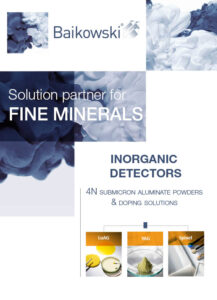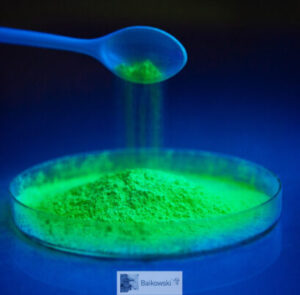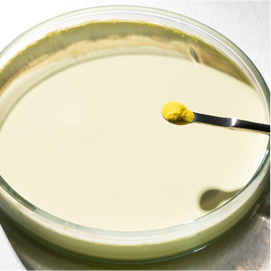YAG phosphor luminescent properties for advanced lighting and imaging technologies
Phosphors exhibit luminescent properties that have led to spectacular breakthroughs in lighting and imaging technologies. Among them, cerium-doped yttrium aluminum garnet (YAG:Ce) standout due to its exceptional efficiency that can be customized to meet specific application requirements.
Light Conversion Phosphor main applications
The main benefit of phosphors is that they can produce different colors of light depending on their chemical composition and the type of energy they absorb. Their ability to convert light wavelengths makes them also crucial in the development of advanced laser technologies with applications ranging from medical to industrial settings.
 For exemple :
For exemple :
- Various neon signs utilize phosphor layers for creating different colors of light.
- Electroluminescent displays, found in aircraft instrument panels and graphic display devices, use a phosphor layer to produce glare-free illumination.
- In the case of white LEDs, widely used for lighting and backlighting, a phosphor coating is applied to convert blue or ultraviolet light into white light.
- Scintillation sensors rely on phosphors to detect radiation and convert it into visible light signals. These sensors are commonly used for medical imaging for diagnostic purposes such as positron emission tomography (PET) and scanners, as well as for security screening or nuclear physics research.
Learn more in our Inorganic detectors white paper
Baikowski® submicronic YAG luminescent enhanced properties
One of the most common Baikowski® light conversion phosphors is yttrium aluminum garnet (YAG) doped with cerium (Ce) ions. The incorporation of cerium enhances YAG’s luminescent properties, allowing it to emit a broad spectrum of light, resulting in high-quality white light output for high-tech applications such as automotive adaptative driving beam headlights (ADB).
 Our high crystallinity, phasic and chemical purity submicronic YAG:Ce powder offers optimized particle size and distribution that makes possible to produce converters compatible with various LED chip designs, exhibiting :
Our high crystallinity, phasic and chemical purity submicronic YAG:Ce powder offers optimized particle size and distribution that makes possible to produce converters compatible with various LED chip designs, exhibiting :
- High efficiency in order to waste little energy as heat and produce a lot of light from the input source, but also to respond quickly and accurately to the input signal, and adjust accordingly.
- Exceptional stability in order to keep the color and brightness consistent over time, without losing quality or intensity.
Thanks to its nanoscale, our YAG phosphors offer unique and outstanding performance in terms of management of light scattering, reduction of optical losses, compatibility with nanostructured blue diodes, and miniaturization of devices.
Learn more about Baikowski® YAG nanophosphors
YAG customization
We can provide superior performance by doping, coating, or creating composites with other materials.

- YAG dopant
One of the methods to enhance the emissive properties of YAG is to add a dopant such as gadolinium (Gd), erbium (Er), holmium (Ho), neodymium (Nd), praseodymium (Pr) or chromium (Cr) depending on the expected properties and applications. - YAG:Ce codopant
Copdopant can change the lattice parameters and the crystal field around Ce ions, affecting their energy levels and emission spectra. Depending on the type and concentration of the codopant, this can lead to a bathochromic or hypsochromic shift of the emission peak, a narrowing or broadening of the emission bandwidth, and an increase or decrease of the emission intensity and quantum yield. - YAG composite structures
YAG:Ce can also be combined with other phosphors to form composite structures able to provide better color quality and luminous efficacy. For example, LuAG-YAG:Ce composite phosphor ceramics can generate white light with tunable color temperature and high luminous efficiency by varying the ratio of LuAG and YAG:Ce.
Ceramics are also recognized for their high thermal conductivity and excellent laser irradiation resistance that make them ideal for color converters in solid-state laser lighting requiring high power and brightness.
Contact us for your specific needs and tailor-made design, including powder processability.
Scientific publication: Improving Optical Transmission of Spark-Plasma-Sintered YAG -Ceramics: Effect of Powder Conditioning and Post-Treatments (May 2021: T.A. Owoseni, A. Rincon Romero, Z. Pala, F. Venturi, E.H. Lester, D.M. Grant, T. Hussain / Baikowski® YAG slurry)
See scientific publications
